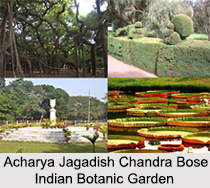 Acharya Jagadish Chandra Bose Indian Botanic Garden is situated in Shibpur, Howrah near Kolkata. It is commonly known as the "Calcutta Botanical Garden" or "Indian Botanic Garden", and previously as the "Royal Botanic Garden". After Independence, the garden was renamed as Indian Botanic Garden in the year 1950. The Botanical Garden was designated the Acharya Jagadish Chandra Bose Indian Botanic Garden on June 25, 2009 in honour of Jagadish Chandra Bose, the Bengali polymath and natural scientist.
Acharya Jagadish Chandra Bose Indian Botanic Garden is situated in Shibpur, Howrah near Kolkata. It is commonly known as the "Calcutta Botanical Garden" or "Indian Botanic Garden", and previously as the "Royal Botanic Garden". After Independence, the garden was renamed as Indian Botanic Garden in the year 1950. The Botanical Garden was designated the Acharya Jagadish Chandra Bose Indian Botanic Garden on June 25, 2009 in honour of Jagadish Chandra Bose, the Bengali polymath and natural scientist.
The Botanical Garden exhibits a wide variety of rare plants and a total collection of over 12,000 specimens spread over 109 hectares. It is under Botanical Survey of India (BSI) of Ministry of Environment and Forests, Government of India. The cynosure of the Botanical Gardens is the huge 250-year-old Banyan tree.
History of Acharya Jagadish Chandra Bose Indian Botanic Garden
Acharya Jagadish Chandra Bose Indian Botanic Garden has a historical past that dates back to the British regime when Kolkata was the capital of India and there was an influx of Europeans from all over the world. Colonel Robert Kyd is credited for the foundation of the Botanical Garden; he in a letter dated 1st June 1786 initiated the proposal of its establishment. He was an amateur botanist apart from being a Secretary to the Board in the Military Department of Fort William, and thought this would be valuable for the trade and commerce a well. April 1787 marked the beginning of the preparatory works for the Garden.
 Kyd undertook schemes under which initially nutmeg, cloves, cinnamon, pepper vines, etc were planted but that failed due to the unsuitable climatic conditions. Same was the case with Equatorial fruits. It is noted that Kyd introduced some 300 species of plants into the Garden. His successor, William Roxburgh, took charge of the Garden on 29th November 1793; Roxburgh introduced the Mahogany tree into the Botanical Garden from West Indian seeds sent by the "Court of Directors" in 1794-95. There is a claim that every Mahogany tree in the region was basically derived from these imports. Similarly, teak was also for the first time planted in the Calcutta Botanical Garden, though Teak plantations were not successful in West Bengal. Roxburgh experimented with fibrous plants and they were more successful of his other experiments.
Kyd undertook schemes under which initially nutmeg, cloves, cinnamon, pepper vines, etc were planted but that failed due to the unsuitable climatic conditions. Same was the case with Equatorial fruits. It is noted that Kyd introduced some 300 species of plants into the Garden. His successor, William Roxburgh, took charge of the Garden on 29th November 1793; Roxburgh introduced the Mahogany tree into the Botanical Garden from West Indian seeds sent by the "Court of Directors" in 1794-95. There is a claim that every Mahogany tree in the region was basically derived from these imports. Similarly, teak was also for the first time planted in the Calcutta Botanical Garden, though Teak plantations were not successful in West Bengal. Roxburgh experimented with fibrous plants and they were more successful of his other experiments.
Attractions in Acharya Jagadish Chandra Bose Indian Botanic Garden
Acharya Jagadish Chandra Bose Indian Botanic Garden also known as Botanical Gardens is laced with a variety of flower and fruit bearing trees. The centrepiece of the garden is undoubtedly the enormous 250 year old The Great Banyan Tree. Besides, a large variety of aquatic plants, particularly the Water Lily is especially very attractive. The Sicilian double coconut tree, the multi-branched Palmyra tree, bamboo trees, and a huge variety of cactus, orchids and other flowering plants makes this place a wonderful location to spend some time discovering the wide variety of flora and natural vegetation. Animals seen inside the Botanical Garden include the Jackal, Indian mongoose and the Indian Fox. A large varieties of snakes are also found in the garden.
The Library of the Acharya Jagadish Chandra Bose Indian Botanic Garden was enhanced and improved by the purchase of Thomson`s personal library. Thomson took charge of the Botanical Garden on 17th April 1855. This place is an ultimate paradise for people with interest in botany and they will find a rare collection of monographs at the in-house library.
This place away from the noise of the city provides a refining experience for the visitors imparting knowledge and visual treat. There are no fees charged for entering the Garden, and one can best enjoy during sunsets and mornings. The Botanical Garden maintains a strict policy against plastic and littering. It is a No-Plastic Zone.











